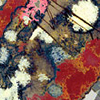Many of the drugs known to be useful in clearing plaques--including AZ plaques--have sulfonic acid end groups. Trodusquemine does, and so does the buffer HEPPS (aka EPPS), which is claimed to "wash away" beta amyloid in a mouse model of AZ. And also taurine (a dirt cheap bile acid), which does the same though not as efficiently.
For taurine--
We orally administered taurine via drinking water to adult APP/PS1 transgenic mouse model for 6 weeks. Taurine treatment rescued cognitive deficits in APP/PS1 mice up to the age-matching wild-type mice in Y-maze and passive avoidance tests without modifying the behaviours of cognitively normal mice. In the cortex of APP/PS1 mice, taurine slightly decreased insoluble fraction of Aβ. While the exact mechanism of taurine in AD has not yet been ascertained, our results suggest that taurine can aid cognitive impairment and may inhibit Aβ-related damages.
https://www.ncbi.nlm...pubmed/25502280
Studies conducted in laboratory animal models using both genetic and dietary models of hyperlipidemia have demonstrated that taurine supplementation retards the initiation and progression of atherosclerosis.
https://www.ncbi.nlm...pubmed/23224908
Another bile acid containing a sulfonic acid end group is TUCDA (a taurine conjugate of ursodeoxycholic acid)--
We have previously reported the therapeutic efficacy of TUDCA treatment before amyloid plaque deposition in APP/PS1 double-transgenic mice. In the present study, we evaluated the protective effects of TUDCA when administrated after the onset of amyloid pathology. APP/PS1 transgenic mice with 7 months of age were injected intraperitoneally with TUDCA (500 mg/kg) every 3 days for 3 months. TUDCA treatment significantly attenuated Aβ deposition in the brain, with a concomitant decrease in Aβ₁₋₄₀ and Aβ₁₋₄₂ levels. The amyloidogenic processing of amyloid precursor protein was also reduced, indicating that TUDCA interferes with Aβ production.
https://www.ncbi.nlm...pubmed/25443293
And finally--
Targeted metabolomic profiling finds bile acid disturbances in Alzheimer’s disease.
Introduction Bile acids play complex roles in cell signalling and immunomodulation and they have been linked to Alzheimer’s disease (AD). This study used LC-MS/MS to comprehensively profile 22 bile acids in brain and plasma from AD patients and APP/PS1 mice. Materials and methods Metabolites in plasma and brain extracts were quantified by an established mass spectral method using the Biocrates Bile Acids kit. Lyophilized and powderised brain tissues (25± 0.5mg) were extracted in ethanol:PBS (300µl; 85%:15%) prior to analysis. Results In human plasma we detected significantly lower cholic acid (CA; 156±74 vs. 947±483µM; n=10) in AD patients than age-matched control subjects. Contrastingly, taurocholic acid was significantly higher (TCA; 87±25 vs. 39±12µM). In APP/PS1 mouse plasma we detected higher CA (10510±4498 vs1811±368µM; 6 months; n=5) and lower hyodeoxycholic acid (1009±226 vs. 364±192µM; 12 months) than WT. In human brain with AD pathology (Braak stages V-VI) TCA (19±6 vs. 4±2µM; n=10) and taurochenodesoxycholic acid (34±10 vs. 13±4 µM) were significantly higher than age-matched control subjects. In APP/PS1 mice we detected higher brain lithocholic acid (6±2 vs. 13±3µM; 6 months) and higher tauromuricholic acid (TMCA; 43±7 vs. 23±8µM; 6 months). TMCA was also elevated in 12 month old APP/PS1 mice (76±21 vs. 12±4 µM) along with 5 others: CA (83±22 vs. 25±7µM), deoxycholic acid (31±5 vs. 24±5µM), β-muricholic acid (73±17 vs. 25±10µM), Ω-muricholic acid (25±6 vs. 8±3µM) and TCA (48±20 vs. 11±7µM). Conclusions We present evidence that bile acid concentrations are disturbed in AD-pathology and further investigation of these changes is clearly warranted.
Edited by Turnbuckle, 14 December 2017 - 02:11 PM.

























































